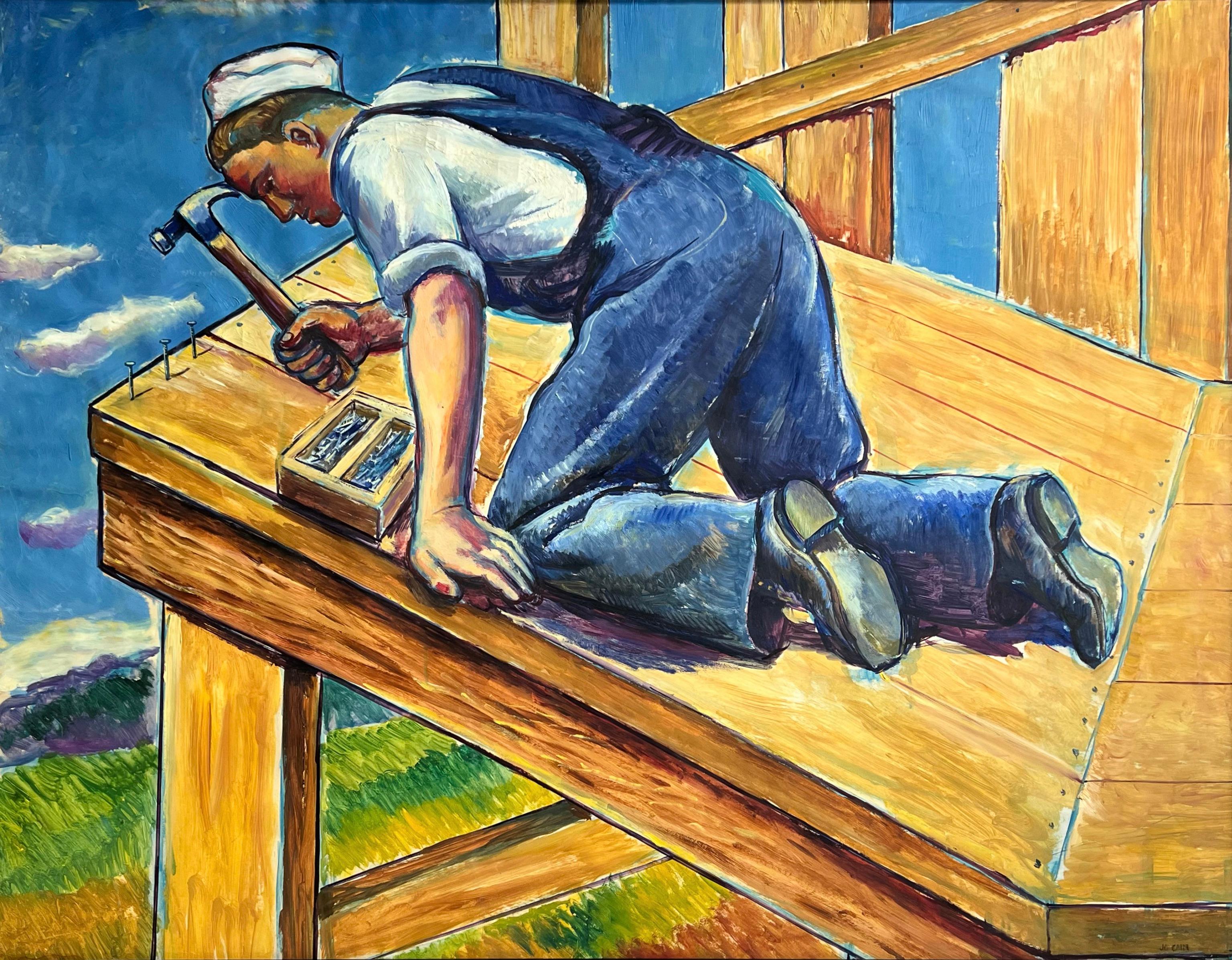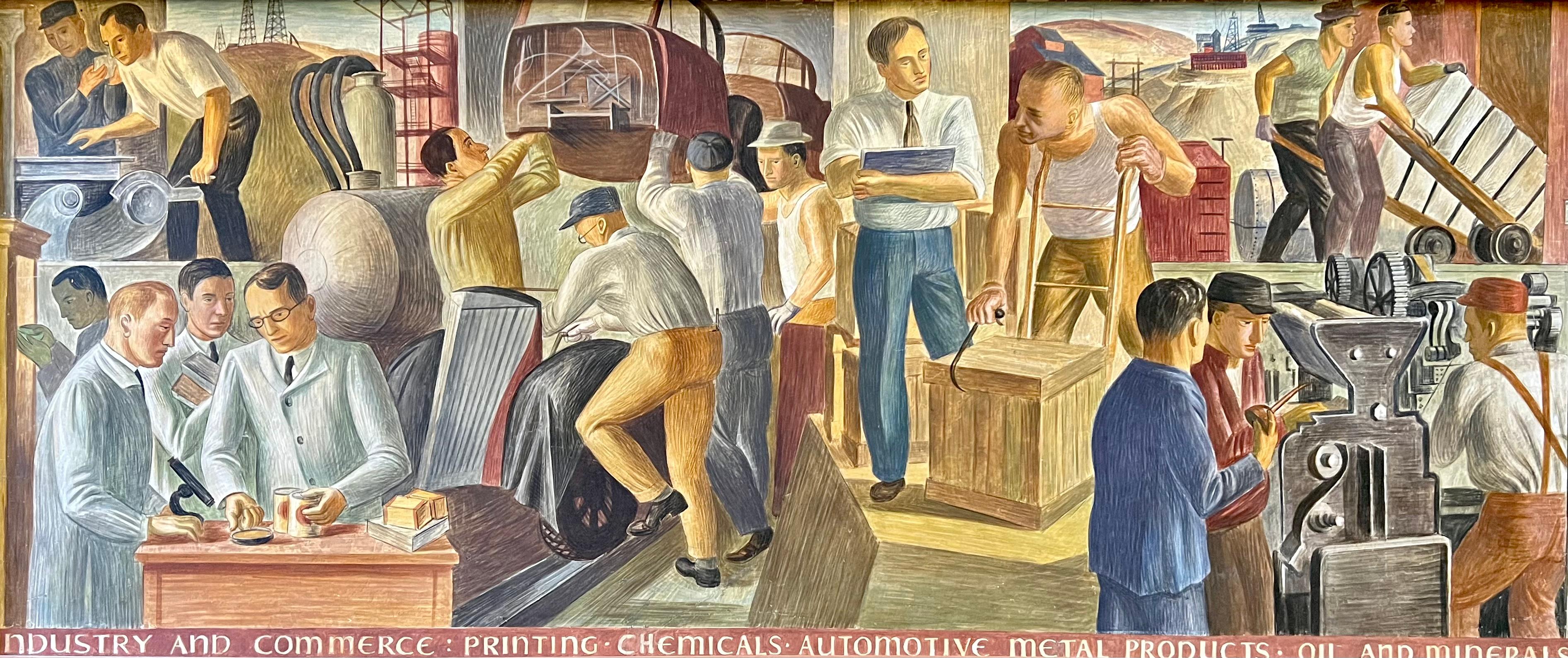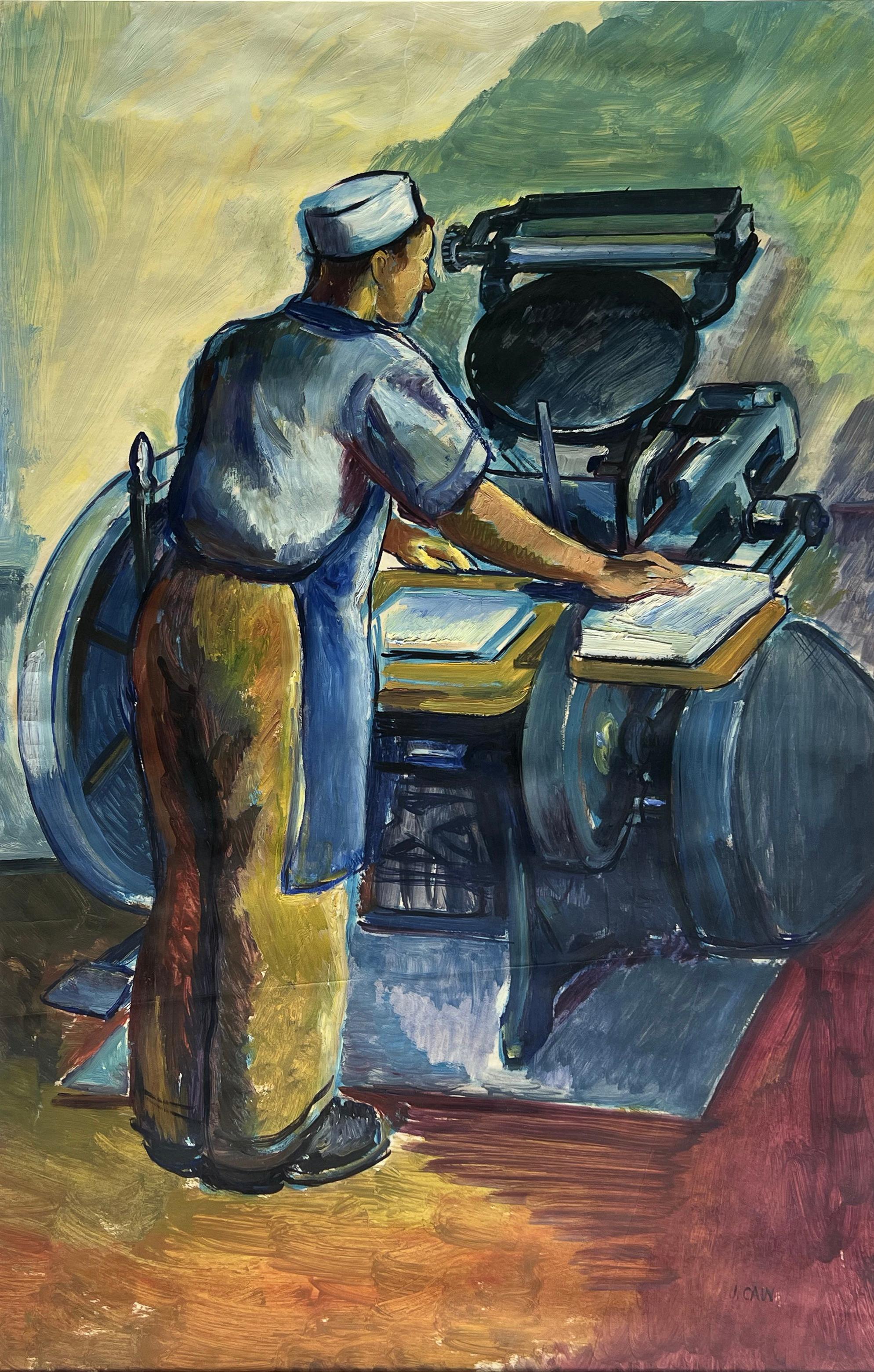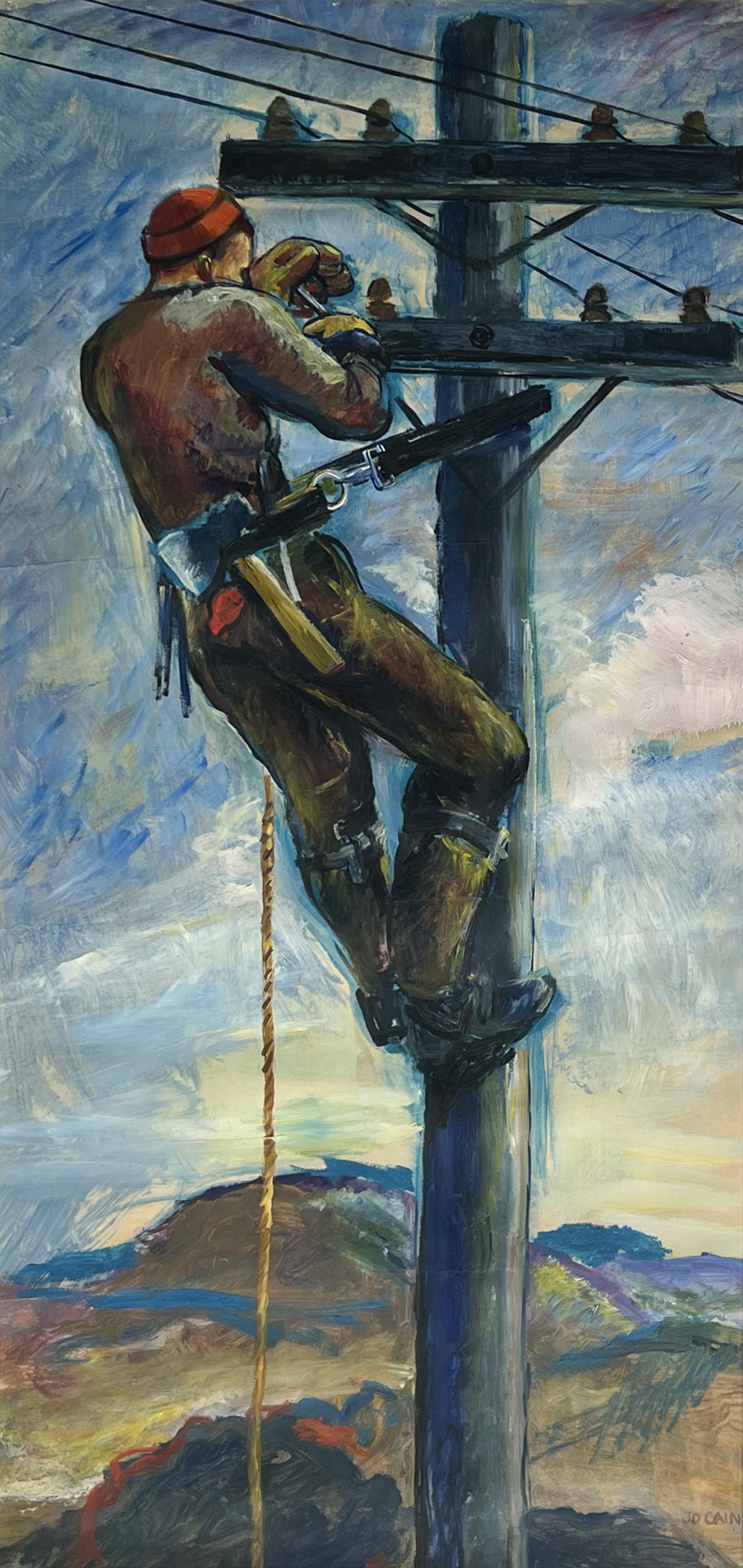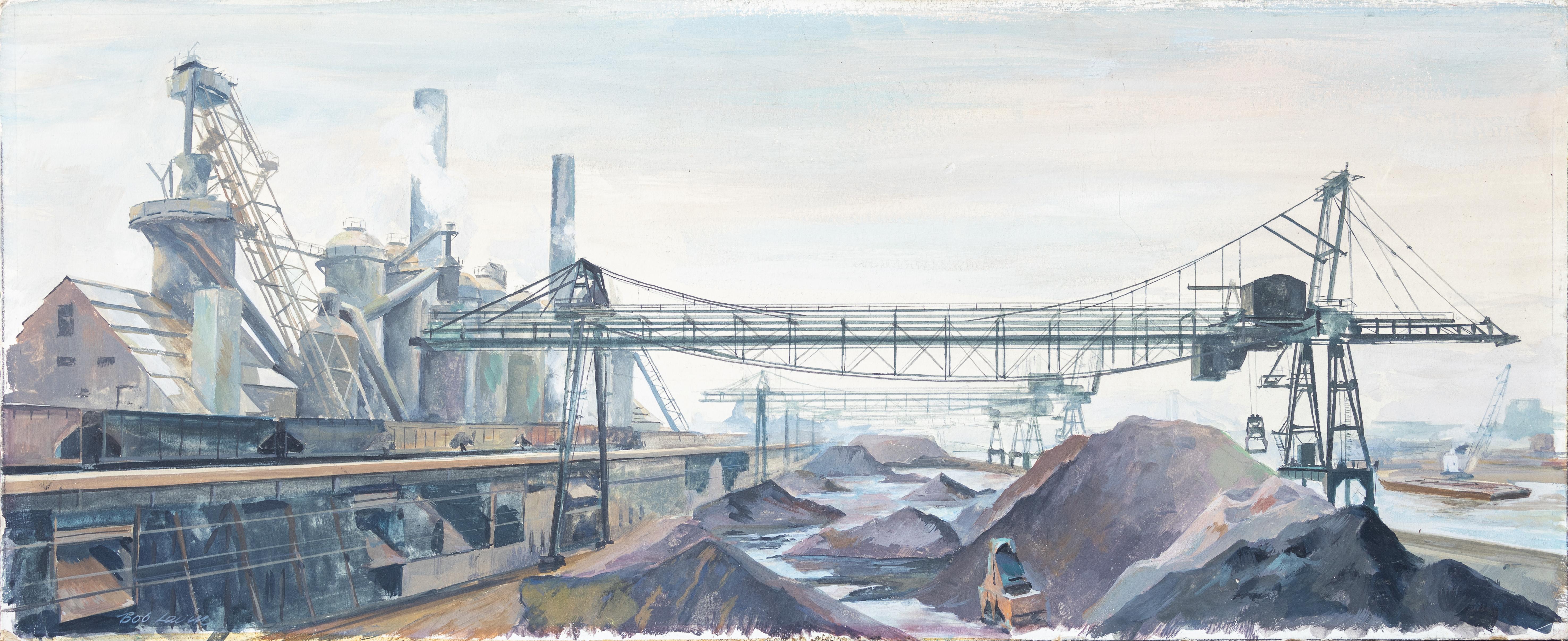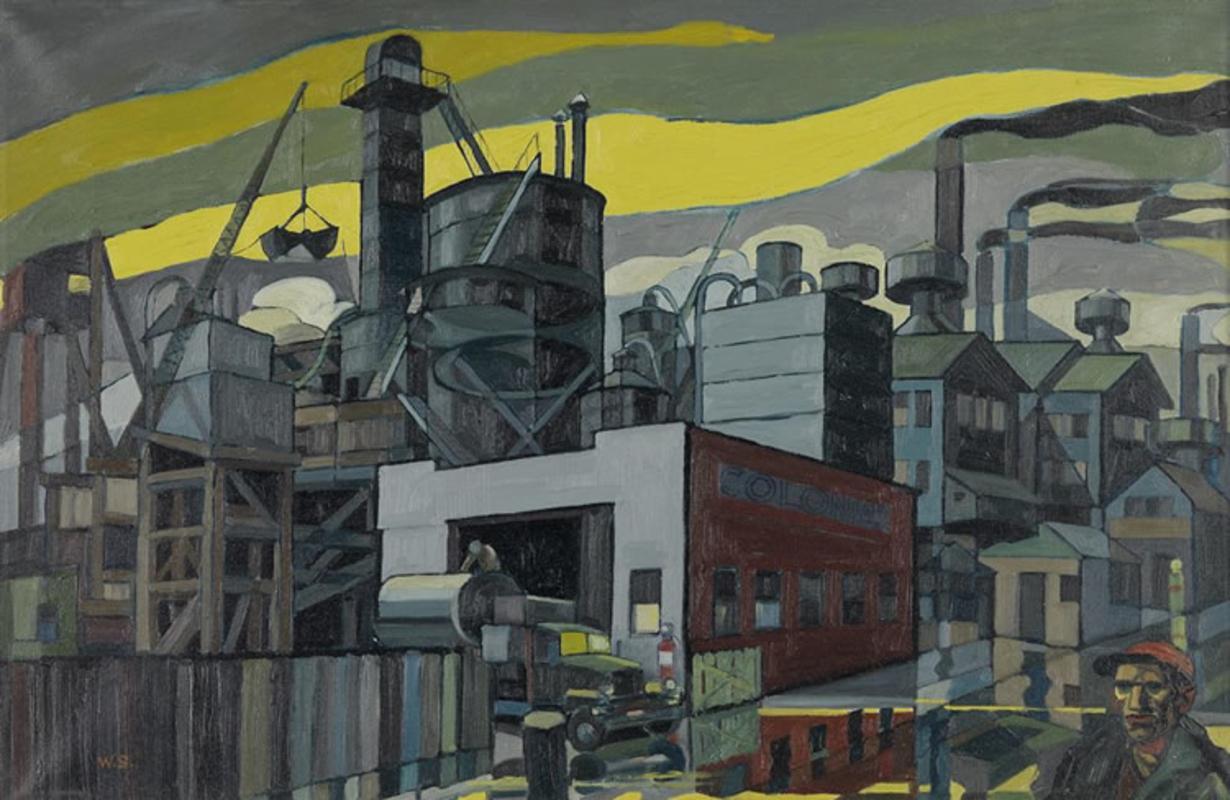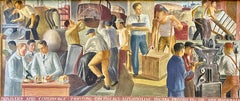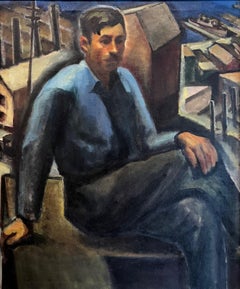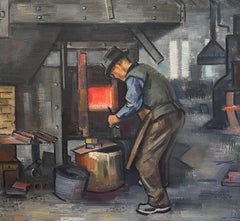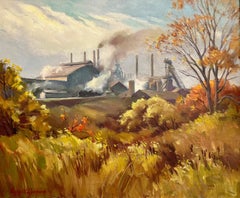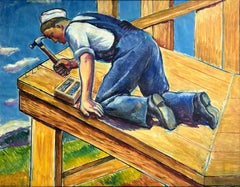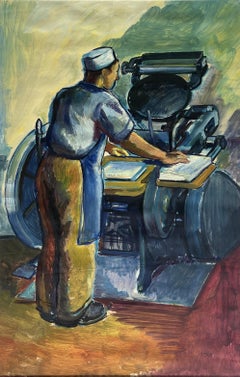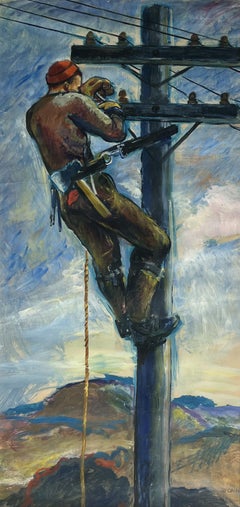Items Similar to Factory Worker
Want more images or videos?
Request additional images or videos from the seller
1 of 6
James Hollins PatrickFactory Workerc. 1936
c. 1936
$6,500
£4,909.24
€5,670.93
CA$9,157.57
A$9,807.77
CHF 5,272.59
MX$119,121.04
NOK 66,621.71
SEK 60,997.13
DKK 42,372.22
About the Item
This painting is part of our exhibition America Coast to Coast: Artists of the 1930s
Factory Worker, c. 1936, oil on canvas, signed lower right, 18 ¼ x 36 inches; exhibited in City Life, Los Angeles: 1930s to 1950s, Laguna Art Museum, February 21 to June 12, 2016, provenance includes George Stern Fine Arts (Los Angeles); presented in a newer very high quality handmade frame from Vandueuren (Los Angeles)
About the Painting
James Patrick’s Factory Worker is a rare painting in terms of subject matter, sensibility, and media. California Scene painters were best known for their bright, usually optimistic and modestly scaled watercolor compositions which depicted California as the Golden State, a destination for those hoping to escape the challenges of the Dust Bowl and South. In contrast, Factory Worker is a sizable oil painting crafted in somber tones of browns, grays and ochres and depicts a laborer standing against the backdrop of a smoke-belching factory on the outskirts of Los Angeles. It is part of a series of works Patrick completed in the mid to late 1930s of Sulphur and vulcanized rubber processing plants in Southern California, two materials that were key to the automobile industry. The work at the Sulphur pits was hot and dangerous, taking a toll on the factory workers and the environment. As Factory Worker shows, these industries released pollution into the air and fouled waterways. Patrick did not sugar coat the scene as he presents the worker staring directly back at the viewer with an ambiguous expression that is at the same time fearful and stoic. Noted California art historian Gordon McClelland described another painting from this series, The Sulphur Pits (The Buck Collection) as “one of the most poignant, yet engaging, scene paintings Patrick produced. The piece visually captures the look and feel of what it was like to visit or work at this type of factory in the 1930s.”
About the Artist
James Patrick was a California Scene painter who was born in British Columbia but grew up in Los Angeles. After graduating from Hollywood High School, Patrick earned a three-year scholarship to the Chouinard School of Art, where he studied with Frank Tolles Chamberlin and Clarence Hinkle. He also studied with Millard Sheets and attended a mural workshop with one of Los Tres Grandes, David Alfaro Siqueiros. Patrick became an instructor at Chouinard, assisted Sheets on several mural projects and even did pre-production art for Walt Disney Studios, including working on Pinocchio and Snow White and the Seven Dwarfs. During World War II, he worked with the US Army on various camouflage projects, and he eventually became the Chief Camoufleur of the Western Defense Commend for the Pacific Coast. Patrick was a member of the California Watercolor Society, serving as its President in 1941. During his short life, he exhibited extensively, including at the Corcoran Gallery, the Art Institute of Chicago, the Pennsylvania Academy of Fine Arts and the National Gallery. He is listed in Who Was Who in American Art and other standard references.
- Creator:James Hollins Patrick (1911 - 1944, American)
- Creation Year:c. 1936
- Dimensions:Height: 18.25 in (46.36 cm)Width: 36 in (91.44 cm)Depth: 2 in (5.08 cm)
- More Editions & Sizes:18.25 x 36Price: $6,500
- Medium:
- Movement & Style:
- Period:
- Condition:
- Gallery Location:Los Angeles, CA
- Reference Number:1stDibs: LU1859213056942
About the Seller
5.0
Vetted Professional Seller
Every seller passes strict standards for authenticity and reliability
1stDibs seller since 2022
18 sales on 1stDibs
Typical response time: 2 hours
- ShippingRetrieving quote...Shipping from: Los Angeles, CA
- Return Policy
More From This Seller
View AllIndustry and Commerce
Located in Los Angeles, CA
This mural study is part of our exhibition America Coast to Coast: Artists of the 1930s
Industry and Commerce, 1936, tempera on panel, 16 ½ x 39 ½ inches, signed verso “John Ballator, Portland Ore.” provenance includes: J.C. Penney Company, represented by Russell Tether Fine Arts Assoc.; presented in a newer wood frame
About the Painting
Industry and Commerce is a prime example of WPA Era muralism. Like a Mediaeval alter, this mural study is filled with icons, but the images of saints and martyrs are replaced with symbols of America's gospel of prosperity through capitalism. Industry and Commerce has a strong narrative quality with vignettes filling the entire surface. Extraction, logistics, design, power generation, and manufacturing for printing, chemicals, automobiles and metal products are all represented. To eliminate any doubt about the mural's themes, Ballator letters a description into the bottom of the study. Ballator also presents an idealized version of industrial cooperation, as his workers, lab-coated technicians and tie-wearing managers work harmoniously toward a common goal in the tidy and neatly designed environments. Although far from the reality of most industrial spaces, Ballator's study reflects the idealized and morale boosting tone that many mural projects adopted during the Great Depression.
About the Artist
John R Ballator achieved success as a muralist, lithographer, and teacher during the Great Depression. Born in Oregon, he studied at the Portland Museum Art School, the University of Oregon and at Yale University where he received a Bachelor of Fine Art. In 1936, Ballator was commissioned to paint a mural panel for the new Department of Justice Building in Washington DC, an important project that spanned five years with several dozen artists contributing a total of sixty-eight designs. Ballator completed murals for the St. Johns Post Office and Franklin High School, both in Portland, Oregon. He also contributed to the 1938 murals at Nathan Hale School in New Haven, Connecticut. During the late 1930s, Ballator taught art for several years at Washburn College in Topeka, Kanas, where he completed a mural for the Menninger Arts & Craft Shop before accepting a professorship at Hollins College...
Category
1930s American Realist Figurative Paintings
Materials
Tempera
A Laborer Resting
By Robert Gilbert
Located in Los Angeles, CA
A Laborer Resting, 1930, oil on canvas, signed and dated lower center, 36 x 30 inches, inscribed verso “July – 1930 / Title – A Laborer Resting / Artist – Robert Gilbert / Price - $2...
Category
1930s American Modern Figurative Paintings
Materials
Canvas, Oil
Blacksmith (Untitled)
By Erle Loran
Located in Los Angeles, CA
Blacksmith (Untitled), 1936, oil on canvas, signed and dated lower right, 28 x 30 inches
Erle Loran was an influential American painter, art historian, and educator, renowned for h...
Category
1930s American Modern Figurative Paintings
Materials
Canvas, Oil
Civilization
Located in Los Angeles, CA
Civilization, c. 1948, oil on canvas, signed lower left, 20 x 24 inches, label verso reads “Eugene M. Dyczkowski / Grand Inland, N. Y. / Civilization,” inscribed verso in the artist’...
Category
1940s American Realist Landscape Paintings
Materials
Canvas, Oil
Quarry Workers
Located in Los Angeles, CA
This painting is part of our exhibition America Coast to Coast: Artists of the 1930s
Quarry Workers, c. 1930s, mixed media on board, unsigned, 24 x 24 inches, possibly exhibited at...
Category
1930s American Modern Figurative Paintings
Materials
Mixed Media
Farm Tragedy (Untitled)
Located in Los Angeles, CA
Farm Tragedy (Untitled), c. 1930s, mixed media on plaster on panel, unsigned, 22 1/8 x 32 inches; label verso reads: "New York Artists Equity Association, New York, NY," provenance i...
Category
1930s American Modern Figurative Paintings
Materials
Mixed Media
You May Also Like
Industrial Man Working Mid 20th Century American Scene Social Realism Modern WPA
By Jo Cain
Located in New York, NY
Industrial Man Working Mid 20th Century American Scene Social Realism Modern WPA
Jo Cain (1904 - 2003)
Hammering Nails
39 x 50 ½ inches
Gouache on paper c. 19...
Category
1930s American Realist Figurative Drawings and Watercolors
Materials
Paper, Gouache
Working Man WPA Social Realism Industrial Modernism 20th Century American Scene
By Jo Cain
Located in New York, NY
Working Man WPA Social Realism Industrial Modernism 20th Century American Scene
Jo Cain (1904 - 2003)
Printing Press
40 ½ x 26 inches (sight)
Oil o...
Category
1930s American Realist Figurative Drawings and Watercolors
Materials
Paper, Oil
Man Working Mid 20th Century American Scene Social Realism Industrial WPA Modern
By Jo Cain
Located in New York, NY
Man Working Mid 20th Century American Scene Social Realism Industrial WPA Modern
Jo Cain (1904 - 2003)
Telephone Pole Worker
38 1/4 x 18 1/2 inches
Oil on pap...
Category
1930s American Realist Figurative Drawings and Watercolors
Materials
Paper, Gouache
"Shipyard" Realist Industrial Landscape
By Robert Lavin
Located in Austin, TX
This painting is a 20th century realist landscape depiction of a shipyard by Robert Lavin. The piece is executed in oil on board and measures 10" x 24".
Robert Lavin was born in New York City. His education included Townsend Harris, a prep school in New York followed by college at City College of New York. He also attended the National Academy of Art, where he studied as a painter. Studying the social realists of the 1930’s, Lavin, a former Marine pilot, portrayed steelworkers, roughnecks and trainmen. Lavin often painted his “proletarian ballets”- as one critic called them – to illustrate magazine advertisements.
The Smithsonian Institution and other museums collected Lavin’s original paintings, which portrayed the laboring subjects with dignity and integrity. Lavin also illustrated stock certificates and books. Paper Money magazine praised him as “one of the greatest vignette artists of the 20th century.” In addition to this, Lavin was for a number of years an Associate Professor of Art at City College of New York, a position he left in the mid ‘60’s in order to devote himself full time to his painting. His commissions took him around the world, from the North Sea to the coast of Africa, from the slopes of Alaska to the Sea of Japan. As part of a series for Gulf Oil, he painted the royal family of England for the opening of a new refinery in Wales. Another portrait of one of the early Americanastronauts, appeared on the cover of Time Magazine. Other major commissions during these years included Readers Digest books...
Category
20th Century American Realist Landscape Paintings
Materials
Oil, Board
Price Upon Request
"Colonial Sand and Stone Company, New York, " Industrial WPA Scene, Precisionist
By William Sharp
Located in New York, NY
William Sharp (1900 - 1961)
Factory on the River
Oil on canvas
20 1/2 x 28 1/2 inches
Initialed lower left: WS
Provenance:
Estate of the artist
Private Collection, New York
Swann Auction Galleries, American Art, June 13, 2019, Lot 178
Private Collection, New York
Colonial Sand and Stone Co., founded by Generoso Pope, was once the country’s largest sand and gravel business, providing the concrete for much of New York City’s skyline, including the Empire State Building, Rockefeller Center, Radio City Music Hall, airports and subways.
William Sharp was born on June 13, 1900, in Lemberg, Austria, where he attended college and the Academy for Arts and Industry. He later studied in Kraków, Poland, and in Berlin and Munich, Germany. Sharp began his career as a designer of stained-glass windows and as a painter of murals. He served in the German army during World War I. After the war he became a newspaper artist in Berlin and a well-known etcher.
Sharp drew political cartoons that were bitterly critical of the growing Nazi movement. As the influence of National Socialism intensified, he began to contribute drawings, under a pseudonym, to publications that were hostile to Hitler. After Hitler assumed power, Sharp was confronted with these drawings and told that he would be sent to a concentration camp. However, in 1934, he escaped to the United States.
His first newspaper assignment in America was making courtroom sketches for The New York Mirror...
Category
Mid-20th Century American Realist Landscape Paintings
Materials
Canvas, Paint, Oil
Railroad Worker Industrial WPA American Scene Mid Century Modern Social Realism
By Jo Cain
Located in New York, NY
Railroad Worker Industrial WPA American Scene Mid Century Modern Social Realism
Jo Cain (1904 - 2003)
Railroad worker
36 ¼ x 27 inches
Oil on paper c. 1930s
S...
Category
1930s American Realist Figurative Drawings and Watercolors
Materials
Paper, Oil
More Ways To Browse
Vintage Worker
Paintings Factory
Pacific Coast Vintage
Seven Dwarfs
Snow White And Seven Dwarfs
Snow White Dwarfs
Frank Tolles Chamberlin
George Stern Fine Arts
Cafe Scene Painting
Charlie Chaplin Vintage
Blue Face Painting
Isaac Pelayo
Kibbutz Art
New Yorker Cover
Opera Singer
Picasso Oil Painting
Shaw London
Vintage Circus Performers
